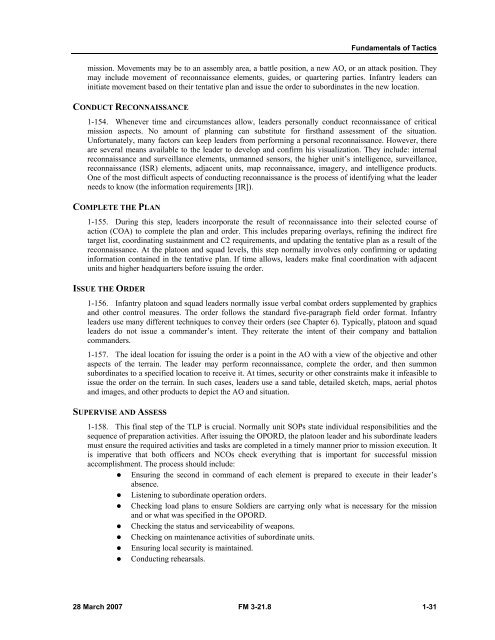Infantry Rifle Platoon and Squad - Sakai
Infantry Rifle Platoon and Squad - Sakai
Infantry Rifle Platoon and Squad - Sakai
You also want an ePaper? Increase the reach of your titles
YUMPU automatically turns print PDFs into web optimized ePapers that Google loves.
Fundamentals of Tactics<br />
mission. Movements may be to an assembly area, a battle position, a new AO, or an attack position. They<br />
may include movement of reconnaissance elements, guides, or quartering parties. <strong>Infantry</strong> leaders can<br />
initiate movement based on their tentative plan <strong>and</strong> issue the order to subordinates in the new location.<br />
CONDUCT RECONNAISSANCE<br />
1-154. Whenever time <strong>and</strong> circumstances allow, leaders personally conduct reconnaissance of critical<br />
mission aspects. No amount of planning can substitute for firsth<strong>and</strong> assessment of the situation.<br />
Unfortunately, many factors can keep leaders from performing a personal reconnaissance. However, there<br />
are several means available to the leader to develop <strong>and</strong> confirm his visualization. They include: internal<br />
reconnaissance <strong>and</strong> surveillance elements, unmanned sensors, the higher unit’s intelligence, surveillance,<br />
reconnaissance (ISR) elements, adjacent units, map reconnaissance, imagery, <strong>and</strong> intelligence products.<br />
One of the most difficult aspects of conducting reconnaissance is the process of identifying what the leader<br />
needs to know (the information requirements [IR]).<br />
COMPLETE THE PLAN<br />
1-155. During this step, leaders incorporate the result of reconnaissance into their selected course of<br />
action (COA) to complete the plan <strong>and</strong> order. This includes preparing overlays, refining the indirect fire<br />
target list, coordinating sustainment <strong>and</strong> C2 requirements, <strong>and</strong> updating the tentative plan as a result of the<br />
reconnaissance. At the platoon <strong>and</strong> squad levels, this step normally involves only confirming or updating<br />
information contained in the tentative plan. If time allows, leaders make final coordination with adjacent<br />
units <strong>and</strong> higher headquarters before issuing the order.<br />
ISSUE THE ORDER<br />
1-156. <strong>Infantry</strong> platoon <strong>and</strong> squad leaders normally issue verbal combat orders supplemented by graphics<br />
<strong>and</strong> other control measures. The order follows the st<strong>and</strong>ard five-paragraph field order format. <strong>Infantry</strong><br />
leaders use many different techniques to convey their orders (see Chapter 6). Typically, platoon <strong>and</strong> squad<br />
leaders do not issue a comm<strong>and</strong>er’s intent. They reiterate the intent of their company <strong>and</strong> battalion<br />
comm<strong>and</strong>ers.<br />
1-157. The ideal location for issuing the order is a point in the AO with a view of the objective <strong>and</strong> other<br />
aspects of the terrain. The leader may perform reconnaissance, complete the order, <strong>and</strong> then summon<br />
subordinates to a specified location to receive it. At times, security or other constraints make it infeasible to<br />
issue the order on the terrain. In such cases, leaders use a s<strong>and</strong> table, detailed sketch, maps, aerial photos<br />
<strong>and</strong> images, <strong>and</strong> other products to depict the AO <strong>and</strong> situation.<br />
SUPERVISE AND ASSESS<br />
1-158. This final step of the TLP is crucial. Normally unit SOPs state individual responsibilities <strong>and</strong> the<br />
sequence of preparation activities. After issuing the OPORD, the platoon leader <strong>and</strong> his subordinate leaders<br />
must ensure the required activities <strong>and</strong> tasks are completed in a timely manner prior to mission execution. It<br />
is imperative that both officers <strong>and</strong> NCOs check everything that is important for successful mission<br />
accomplishment. The process should include:<br />
• Ensuring the second in comm<strong>and</strong> of each element is prepared to execute in their leader’s<br />
absence.<br />
• Listening to subordinate operation orders.<br />
• Checking load plans to ensure Soldiers are carrying only what is necessary for the mission<br />
<strong>and</strong> or what was specified in the OPORD.<br />
• Checking the status <strong>and</strong> serviceability of weapons.<br />
• Checking on maintenance activities of subordinate units.<br />
• Ensuring local security is maintained.<br />
• Conducting rehearsals.<br />
28 March 2007 FM 3-21.8 1-31

















